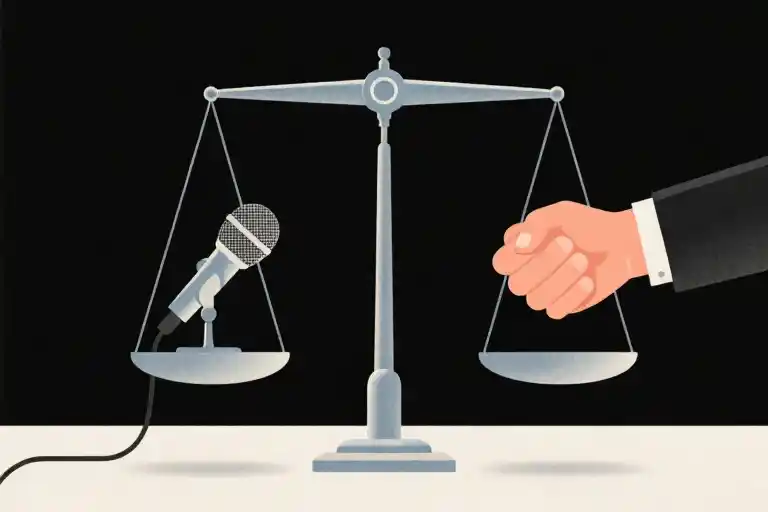The boardroom was dead silent when Otis made his move. My weathered ventriloquist dummy leaned toward the CFO, his painted eyebrows wiggling with conspiratorial glee. ‘Say, you look just like my cousin Earl – except he lost that finger in a woodchipper accident. You still got all yours?’ The tension shattered like dropped china as executives erupted in laughter. Not at the joke – but at the sheer audacity of a fabric-faced creature interrogating their boss.
This scene repeats itself in corporate events, cruise ships, and comedy clubs across the country. After thirty-five years of letting inanimate objects do my talking, I’ve discovered an uncomfortable truth: Plastic puppets communicate better than most living humans. They interrupt CEOs without consequences. They ask inappropriate questions that become charming instead of career-ending. They make audiences lean forward when polished PowerPoints make them doze off.
What began as a vaudeville novelty act became my graduate program in human connection. These dummies – literal sacks of sawdust and polyester – taught me more about authentic communication than any business seminar. Their secret? Embracing what psychologists call ‘character distance,’ that magical space where messages gain immunity through a messenger who isn’t quite real. When Otis insults someone, it’s hilarious. When I do it? That’s a lawsuit.
The corporate world is finally catching on. Silicon Valley CEOs adopt alter egos for tough negotiations. Sales teams role-play as ‘confident versions’ of themselves. Even neuroscientists confirm what puppeteers knew instinctively: Giving your words some psychological distance makes them land differently in listeners’ brains.
Over the next sections, we’ll unpack five counterintuitive lessons from my trunk-dwelling colleagues:
- Why letting someone else say it (even if that someone is a sock) creates instant credibility
- The hidden power of strategic silence – and how to use pauses like punctuation
- What ventriloquist dummy design teaches about crafting your professional persona
- Reading rooms with the precision of a stand-up comic
- Practicing until you can afford to forget everything
No puppets required – just willingness to occasionally look foolish. As my grumpiest dummy Elmer would say: ‘Smart people talk. Wise people let the dummy do it.’
The Power of Role Distance: Let Your Alter Ego Say What You Can’t
There’s an uncomfortable truth veteran performers learn early: audiences often prefer talking to a piece of wood than an actual human. My dummy Otis gets away with remarks that would end my corporate gigs – like insisting he recognizes an executive’s wife from a Reno bachelorette party. This isn’t just ventriloquist magic; it’s psychological armor. When Otis ‘remembers’ improbable details about strangers, he’s demonstrating how role distance creates conversational safety nets.
Psychologists call this the ‘puppet buffer effect.’ Studies at Stanford’s Virtual Human Interaction Lab found people confess more to digital avatars than human interviewers. David Bowie understood this when he created Ziggy Stardust – a flamboyant alien persona that allowed the shy Brixton boy to command stadiums. In business contexts, I’ve watched sales teams adopt ‘expert characters’ during tough negotiations, their confidence visibly bolstered by these temporary identities.
Building Your Performance Persona
- The Naming Ceremony: Like Eminem’s Slim Shady or Prince’s Camille, give your alter ego a distinct name. Mine is ‘Chester,’ a sarcastic hedge fund manager who wears imaginary suspenders.
- Costume Cues: Even subtle props help – glasses for ‘professor mode,’ rolled sleeves for ‘hands-on leader.’ My corporate clients report using signature colors (a purple tie for creativity, red heels for authority).
- Backstory Briefing: Decide three key traits. Otis is forgetful but well-meaning; Elmer is cynical but wise. This prevents inconsistent reactions under pressure.
During a pharmaceutical conference, I witnessed a researcher paralyzed by stage fright transform when introducing ‘Dr. Chen,’ her bolder Canadian counterpart. By the Q&A, she was effortlessly batting away challenges – “Dr. Chen would remind you that trial data shows…” The room never suspected her Vancouver accent was as genuine as Otis’ dental records.
Why This Works
Neuroscience reveals our brains process alter egos differently. University College London studies show role-play activates the dorsolateral prefrontal cortex, reducing amygdala-driven fear responses. Essentially, your ‘Chester’ or ‘Dr. Chen’ literally thinks differently than your panicked self.
Try this today: Before your next high-stakes interaction, spend two minutes answering as your persona would. Notice how “I’m nervous about this pitch” becomes “My team’s excited to show you three game-changers.” The words may come from your mouth, but the courage comes from psychological distance – the same space where Otis’ outrageous claims somehow feel acceptable.
Remember: All great performers understand masks don’t hide who we are; they reveal who we might become. Your most authentic communication might begin with a very inauthentic plastic head.
The Art of Shutting Up: When Silence Speaks Louder
There’s a particular magic trick ventriloquists don’t talk about often – it’s not the lip control or the voice throwing, but the strategic deployment of silence. My dummy Otis once ‘froze’ for eight full seconds during a corporate gig after delivering an outrageous claim about the CEO’s hairpiece. The room went from nervous titters to roaring laughter purely because of that pregnant pause. That’s when I learned plastic heads have better comedic timing than most humans.
The Ventriloquist’s Pause
What audiences perceive as spontaneous ‘dummy thinking time’ is actually a calculated technique we call the elastic pause. Here’s how it works:
- The Setup: Otis says something mildly provocative (“Your supply chain moves slower than my grandpa after chili night”)
- The Stall: I let his head droop slightly, eyes blinking at irregular intervals
- The Payoff: After 3-5 seconds (an eternity on stage), he delivers the twist (“…and he died in ’93”)
This works because silence does three crucial things:
- Builds anticipation (our brains hate unresolved tension)
- Creates the illusion of independent thought
- Gives the audience time to mentally participate
Corporate Case Study: When Silence Saved a Quarterly Report
Last year, a Fortune 500 client asked me to observe their CFO’s disastrous earnings call rehearsal. The executive kept plowing through slides after losing his place, creating a death spiral of verbal flotsam. We implemented three silence tactics:
- The Reset Pause: 2-second stop after each major metric
- The Power Void: When challenged, counting to three before responding
- The Crowd Surf: Letting awkward silences be filled by eager VPs
The actual call saw 18% fewer interruptions and – according to their comms team – ‘the first spontaneous applause during depreciation explanations.’
Your Turn: The 2-Second Challenge
Try this at your next meeting:
- When asked a question, mentally say “Otis would…” before answering
- Count two Mississippi in your head
- Respond in a slightly lower register
This isn’t about artificial delays – it’s creating space for your best thoughts to surface. Most people fear silence more than public speaking itself. The moment you become comfortable with quiet gaps is the moment you start controlling rooms instead of being controlled by them.
Pro Tip: If you accidentally wait too long and someone jumps in, you’ve just discovered that person’s insecurity threshold. File that information for later.
What makes this technique particularly effective is its transferability across contexts. The same pause that makes a dummy seem alive can make a nervous presenter seem thoughtful, or turn a sales pitch into a conversation. It’s the vocal equivalent of wearing black on stage – it makes everything else look more intentional.
Remember: In nature, voids create attraction. Air rushes to fill vacuum, moths flock to dark spaces between stars, and meeting rooms will compulsively lean into your carefully crafted silences. The next time you speak, try speaking less. Let the quiet parts do their work. As my grumpiest dummy Elmer likes to say, “Closed mouths don’t foot-in them.”
The Eyebrows Have It: Crafting Your Human Puppet Persona
Backstage at a corporate gig last year, I watched a CEO adjust his tie seven times before walking onstage. His fingers trembled slightly—the same nervous tic I’ve seen in rookie ventriloquists fumbling with their dummy’s bowtie. The parallel struck me: we’re all just puppeteers designing our human shells before facing the crowd.
My grumpy old puppet Elmer teaches this lesson best. With his permanent scowl (achieved through precisely angled eyebrows carved from basswood), he establishes authority before uttering a word. Audiences immediately understand they’re dealing with a no-nonsense character. That’s the power of intentional design—whether in carved wood or business casual.
The Camera Lens Is Your New Puppet Stage
Virtual meetings have turned our webcams into modern ventriloquist stages. The frame containing your face functions like a puppet’s proscenium, with every visible element contributing to the character you’re presenting:
- Camera angle = puppet’s head tilt (slightly elevated projects confidence)
- Background = puppet stage setting (cluttered bookshelves suggest intellect, blank walls imply focus)
- Lighting = puppet spotlighting (front light minimizes shadows that create unintended “scowls”)
I once performed for a tech company where the CTO’s floating head (improperly framed) became the talk of the conference. We fixed it by applying puppet staging principles—lowering his camera to include subtle shoulder movements that conveyed engagement.
Your Wardrobe Is Costume Design
Ventriloquists know fabric choice matters. A velvet jacket makes a puppet look refined; denim suggests approachability. Your clothing operates similarly:
- Texture telegraphs (tweed jackets whisper “professor”, silk blouses murmur “executive”)
- Color conducts emotion (my optimistic puppet Otis always wears yellow suspenders)
- Details anchor character (Elmer’s single undone button hints at rebelliousness)
A financial advisor client adopted this mindset, swapping his aggressive red ties for navy blue—a shift that made clients describe him as “trustworthy” rather than “intense.”
The Micro-Expressions You Can Control
Puppets lack subtle facial movements, so we exaggerate key features. Humans should do the opposite—curate controllable expressions:
- Eyebrow choreography (slight lift for questions, furrow for emphasis)
- Mouth corner awareness (resting frown face loses audiences)
- Nod calibration (overdone resembles a bobblehead doll)
During virtual presentations, I keep a small mirror beside my monitor—not from vanity, but to monitor if my “human puppet” face matches the tone of my words, just as I adjust my dummies’ expressions mid-performance.
Your Turn to Design
Before your next important appearance, conduct this backstage check:
- Character audit: What three traits should your appearance telegraph? (Example: knowledgeable/approachable/enthusiastic)
- Prop assessment: What visible objects reinforce this? (Glasses? Notebook? Coffee mug?)
- Tech rehearsal: Test your virtual setup with the same scrutiny I give new puppet stages
Remember—you’re not being inauthentic by designing your visible self any more than Shakespeare was false for writing distinct characters. As Elmer would growl while adjusting his tiny suspenders: “If you’re gonna be a dummy, at least be an intentional one.”
Reading the Room When Your Audience Feels Stiffer Than a Puppet
There’s a particular kind of dread that creeps in when you realize your audience has collectively transformed into human mannequins. I’ve seen it happen mid-show – one moment Otis is riffing about corporate jargon, the next we’re met with the kind of silence usually reserved for tax audits. Through years of performing for everyone from bored executives to over-caffeinated college students, I’ve learned audiences aren’t passive receptacles; they’re living mood rings requiring constant interpretation.
The Corporate vs. Campus Conundrum
Performing for boardrooms versus bars requires completely different approaches, much like how my puppet Elmer (the perpetually grumpy retiree) interacts differently with CEOs versus college kids. At corporate events, dry wit wrapped in industry-specific references lands better than broad physical comedy. That same physical bit might kill at a university homecoming show where energy trumps nuance. The key lies in rapid audience assessment during your first few minutes:
- Suit-heavy crowds respond to self-deprecating humor about workplace absurdities (“My puppet has better work-life balance than your HR department”)
- Younger audiences crave relatable generational humor (“Otis just got canceled on PuppetTok”)
- Mixed demographics need universal themes – family dynamics, technology frustrations, or my personal favorite, mocking airline experiences
The Emergency Laughter Toolkit
When you sense attention drifting faster than a puppeteer’s sanity, these three techniques have saved more performances than I can count:
- Strategic Self-Roasting
A well-placed jab at yourself functions like social WD-40. When a joke bombs, I’ll have Otis deadpan: “Steve wrote that one during his fourth whiskey. Let’s never speak of it again.” This accomplishes three things: acknowledges the awkwardness, demonstrates emotional control, and gives permission to laugh at failure. - Environmental Improv
Commenting on shared surroundings creates instant camaraderie. Noticed someone checking their watch? Have your puppet stage-whisper: “Either Bob has a hot date or he’s calculating my hourly rate.” The best material often isn’t in your script – it’s in the room’s thermostat, the weird venue art, or the CEO’s aggressively shiny forehead. - Reverse Q&A
Instead of waiting for questions, prime the pump with outrageous hypotheticals: “If our company were a breakfast food, would we be nutritious oatmeal or suspiciously shiny donuts?” This works particularly well when you notice side conversations developing – it’s easier to redirect energy than compete with it.
Digital Puppetry: Zoom Room Survival
Virtual presentations present unique challenges – you’re essentially performing for a grid of talking postage stamps. My adapted approach:
- Camera-Angle Choreography
Treat your webcam like a puppet stage. Position yourself so hand gestures remain visible (critical for emphasis) and maintain “eye contact” by looking at the camera lens, not participants’ faces. I literally draw googly eyes around my webcam as a reminder. - Otis-Style Digital Icebreakers
In virtual settings, playfully “recognizing” attendees works wonders: “Karen from accounting! We met in that brutal 2017 budget meeting, right?” Even if incorrect, this faux familiarity breaks the fourth wall of digital formality. For larger groups, have your puppet “spot” someone with a distinctive background: “I’d know that bookshelf anywhere – Dave’s a fellow Harry Potter fan!” - Controlled Chaos
Intentionally create minor technical difficulties to humanize the experience. Have your puppet “accidentally” mute you: “Steve’s frozen again – must be buffering his jokes like he buffers his emotions.” This transforms glitches into bonding moments.
What makes these techniques work isn’t just their content, but their underlying philosophy: audiences don’t need perfect performers – they want guides who acknowledge the shared absurdity of human interaction. Sometimes the most professional thing you can do is strategically play the fool.
Rehearse to Perfection, Then Let It Go
Backstage before a show, you’ll find me running through routines with my dummies like an obsessive puppeteer. Otis gets his sarcastic one-liners polished, Elmer rehearses his grumpy old man schtick, and I… well, I’m mostly just trying to remember which puppet says what. After thirty-five years, you’d think I’d have this down, but here’s the dirty little secret of ventriloquism: the spontaneity audiences love is usually the result of borderline neurotic preparation.
Muscle Memory Before Magic
Stagehands have seen me do the same vocal warmups for decades – tongue twisters at 3 PM, lip rolls at 3:15, that ridiculous “red leather, yellow leather” chant at 3:30. It’s not glamorous, but neither is choking on stage because your mouth forgot how to form consonants. The corporate speakers I coach often resist this level of repetition, insisting their PowerPoint will carry them. Then they wonder why their delivery sounds like a GPS voice reading terms and conditions.
Here’s what wood and cloth taught me about preparation:
- Drill until it hurts, then drill more – My puppet routines get rehearsed in the shower, during traffic jams, even while brushing teeth. The goal isn’t to memorize lines but to make the material part of your physical being.
- Record everything – Watching playback of last night’s corporate gig revealed I blink excessively during Q&A. Now I practice with metronome clicks to break the habit.
- Create failure scenarios – I intentionally botch lines during rehearsals to practice recovery. You haven’t lived until you’ve seen a puppet blame technical difficulties for its own forgetfulness.
The Planned Mistake Principle
Early in my career, a snapped control string left Otis’ head lolling like a drunk marionette. The audience howled, assuming it was part of the act. That’s when I discovered the golden rule: perfection terrifies people; controlled flaws invite them in.
Now I build intentional “mistakes” into every performance:
- Letting Elmer “mishear” an audience member’s name
- Having Otis forget why he entered mid-conversation
- Purposeful microphone feedback during dramatic pauses
In boardrooms, this translates to:
- Admitting you need a moment to find a statistic rather than fumbling silently
- Calling attention to a slide error with humor (“Well, that percentage was clearly optimistic”)
- Using audience questions to revisit points you flubbed earlier
The 50/50 Illusion
New puppeteers always ask how much of my show is scripted versus improvised. The answer is both everything and nothing. Every laugh line gets road-tested, every transition timed… but the magic happens in the 20% gaps left for audience energy.
Your next presentation should follow the same rhythm:
- Solid Foundation – Know your opening/closing by heart, plus three key stories or data points.
- Flexible Middle – Identify modular content that can expand or contract based on crowd reactions.
- Escape Hatches – Prepare transition phrases (“What’s fascinating about that…”) to pivot when needed.
During a recent tech conference, I watched a keynote speaker abandon half her slides after noticing the crowd’s glaze-eyed reaction to statistics. She seamlessly shifted to case studies, using the discarded slides as a punchline (“I’ll email these to your insomnia support group”). That’s the sweet spot – preparation giving you permission to improvise.
Leaving Room for the Unexpected
Otis developed his signature “knowing someone in the audience” bit because I once genuinely forgot a wealthy donor’s name during a charity event. The puppet saved me by declaring, “You look exactly like my cousin’s podiatrist!” Now it’s a crowd favorite.
That’s the final lesson from the trunk: mastery isn’t about eliminating surprises but developing tools to embrace them. Your rehearsed material exists to free mental bandwidth, not constrain you. When the lights come up, trust that your preparation will surface when needed – often in ways you never drilled.
So go ahead, practice that investor pitch until you can deliver it in your sleep. Then wake up enough to let the room shape it. Because whether you’re made of flesh or felt, the best performances live in that tension between discipline and daring.
The Puppeteer’s Final Bow
That time Otis ‘recognized’ a Fortune 500 CEO as his long-lost cousin from Reno still makes me chuckle. The absurdity of a wooden-faced creature claiming improbable connections somehow opened doors no corporate icebreaker ever could. Over three decades of making inanimate objects seem human taught me this paradox: We connect best when we’re willing to become slightly unreal ourselves.
The Ventriloquist’s Paradox
There’s something beautifully twisted about puppets teaching humanity. My trunk full of fabric personalities showed me that:
- Distance creates intimacy – When Otis delivers an edgy joke, it lands because the audience knows they’re not really laughing at me
- Imperfection builds trust – Elmer’s occasional ‘malfunctions’ (a stuck jaw, delayed reaction) make him more endearing
- Control comes from release – The best moments happen when I stop micromanaging every eyebrow twitch
These aren’t just stage tricks. They’re survival skills for boardrooms, classrooms, and every space where real humans gather to pretend they’re not nervous.
Your Turn Backstage
Before you close this tab thinking “I’m no performer,” consider:
- That Zoom call where you wished someone else could take over? That’s your Otis moment
- The presentation where you froze? Perfect opportunity for an Elmer-style ‘technical difficulty’
- The awkward networking event? Classic case for imaginary relatives from Reno
This week, try this backstage exercise:
- Name your alter ego (Mine’s ‘Uncle Chester’, the fearless cruise ship comic)
- Give them one signature trait (Chester always wears mismatched socks)
- Let them handle your next high-pressure interaction
The Last Laugh
Professional communicators spend fortunes on speech coaches and PowerPoint consultants. Maybe we’re overcomplicating things. Sometimes the deepest human connection comes through a carved piece of maple with googly eyes.
“The truth is funny enough,” Elmer would growl while adjusting his suspenders. “We just need enough distance to see it.”
So go ahead. Be someone’s dummy for a day. The worst that can happen? You’ll give people something real to laugh about.





